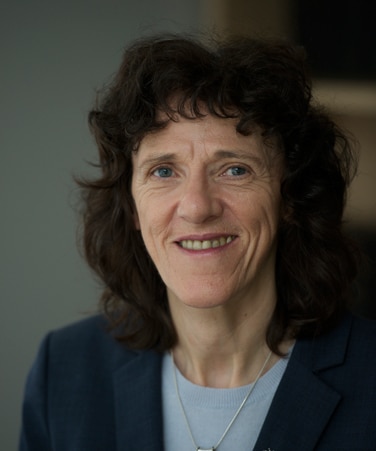Posted on December 16, 2015 in ASRC News
Dr. Gillian Small, CUNY Vice Chancellor for Research and Executive Director of the CUNY Advanced Science Research Center (ASRC), addressed members of the architectural community about the innovative design of the ASRC as part of the Flad Architects Roundtable 2015 on October 29 at The Cornell Club in Manhattan.
The Roundtable — part of a regular series of discussions on the future of design in the science and technology industry — focused on the benefits of a strongly collaborative, interdisciplinary research workplace for the sciences. Small spoke about how the design of scientific research centers such as the ASRC has changed to reflect this new emphasis on collaborative research methodologies required to solve some of the questions 21st Century scientists face.

“While the traditional university structure might have scientific disciplines spread throughout a sprawling campus, the ASRC allows CUNY researchers to come together in a centralized location to utilize some of the most sophisticated instrumentation in the United States.”
“The process was driven by Small’s vision for developing a truly exceptional interdisciplinary and collaborative environment in which to conduct the highest levels of scientific research,” stated David Halpern, Flad project manager. “Based on her five core areas of research, the project team focused on developing a facility that was highly flexible and sustainable, allowing it to adapt to changing research protocols of the future. The sophistication in core facility design enables cross-disciplinary research to be conducted at the forefront of science. Not only is this important to the institution, it provides a platform for outreach to the research community. It was a pleasure to help plan and design a facility where such commitment to a vision was made a reality and to have Small share her vision at Flad’s Roundtable.”
With the increased focus on collaborative work in scientific research in the 21st Century — specifically noting the significant increase in authorship on most modern studies —Small highlighted CUNY’s myriad programs designed to position the University at the forefront in the STEM fields (science, technology, engineering and mathematics).
Small also discussed how the ASRC would serve the CUNY system and also the city’s research community. “Our initiative directors are not only top-level scientists and leaders in their fields,” she said, “they also have the talent to bring faculty and researchers together. They have already begun developing collaborations within CUNY and partnerships with peer institutions in New York. The ASRC is constructed to allow researchers at the center to work closely with others in the scientific community and to think broadly and collaboratively across disciplines to address the most challenging questions in their fields.”
Roundtable attendees were also given an opportunity to tour the ASRC in advance of the symposium.
The innovative architecture of the ASRC and City College of New York’s Center for Discovery & Innovation was recently featured in Architecture Record; click here to read more.
###
About the ASRC: The CUNY Advanced Science Research Center (ASRC) is a University-wide venture that elevates CUNY’s legacy of scientific research and education through initiatives in five distinctive, but increasingly interconnected disciplines: Nanoscience, Photonics, Structural Biology, Neuroscience and Environmental Sciences. Led by Dr. Gillian Small, Vice Chancellor for Research and the ASRC’s executive director, the center is designed to promote a unique, interdisciplinary research culture. Researchers from each of the initiatives work side by side in the ASRC’s core facilities, sharing equipment that is among the most advanced available. Funding for the ASRC from New York State is gratefully acknowledged.
###
